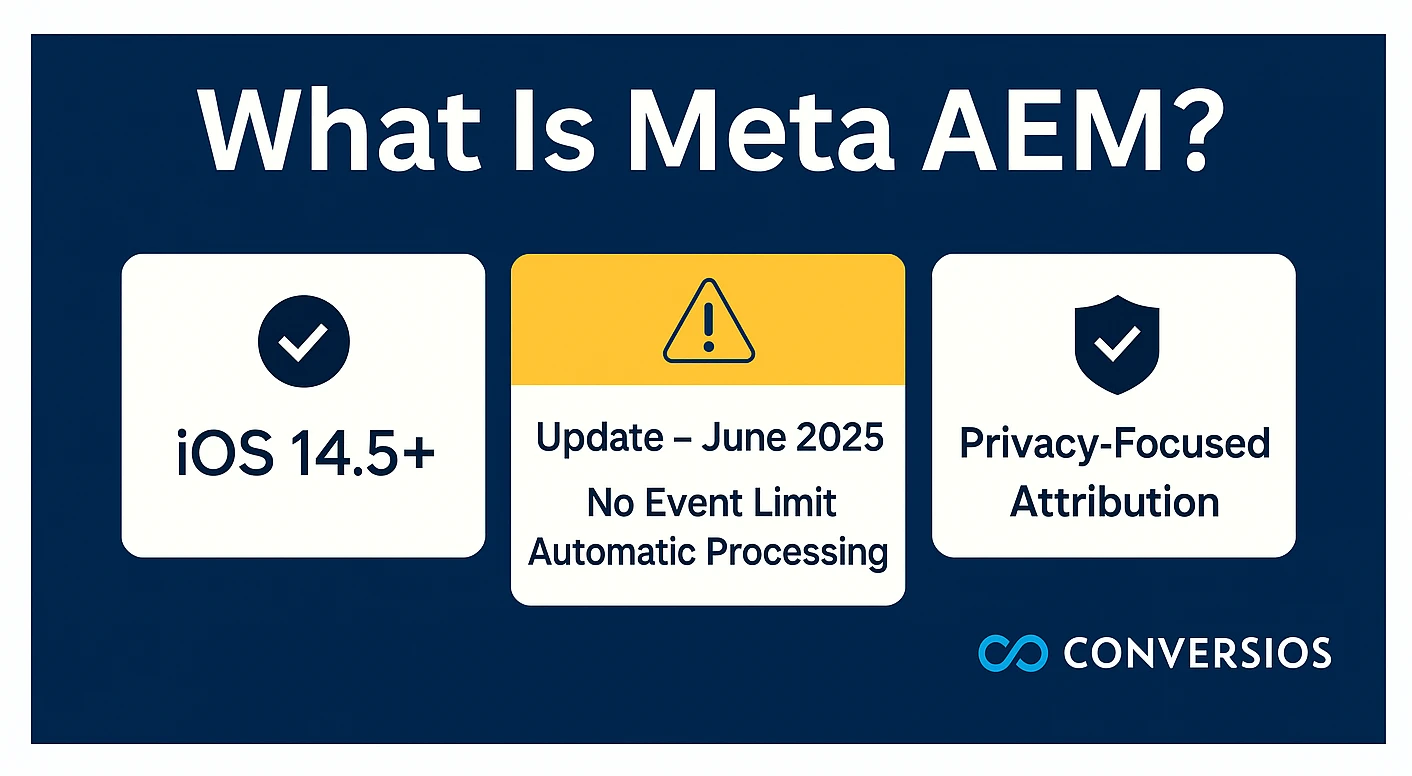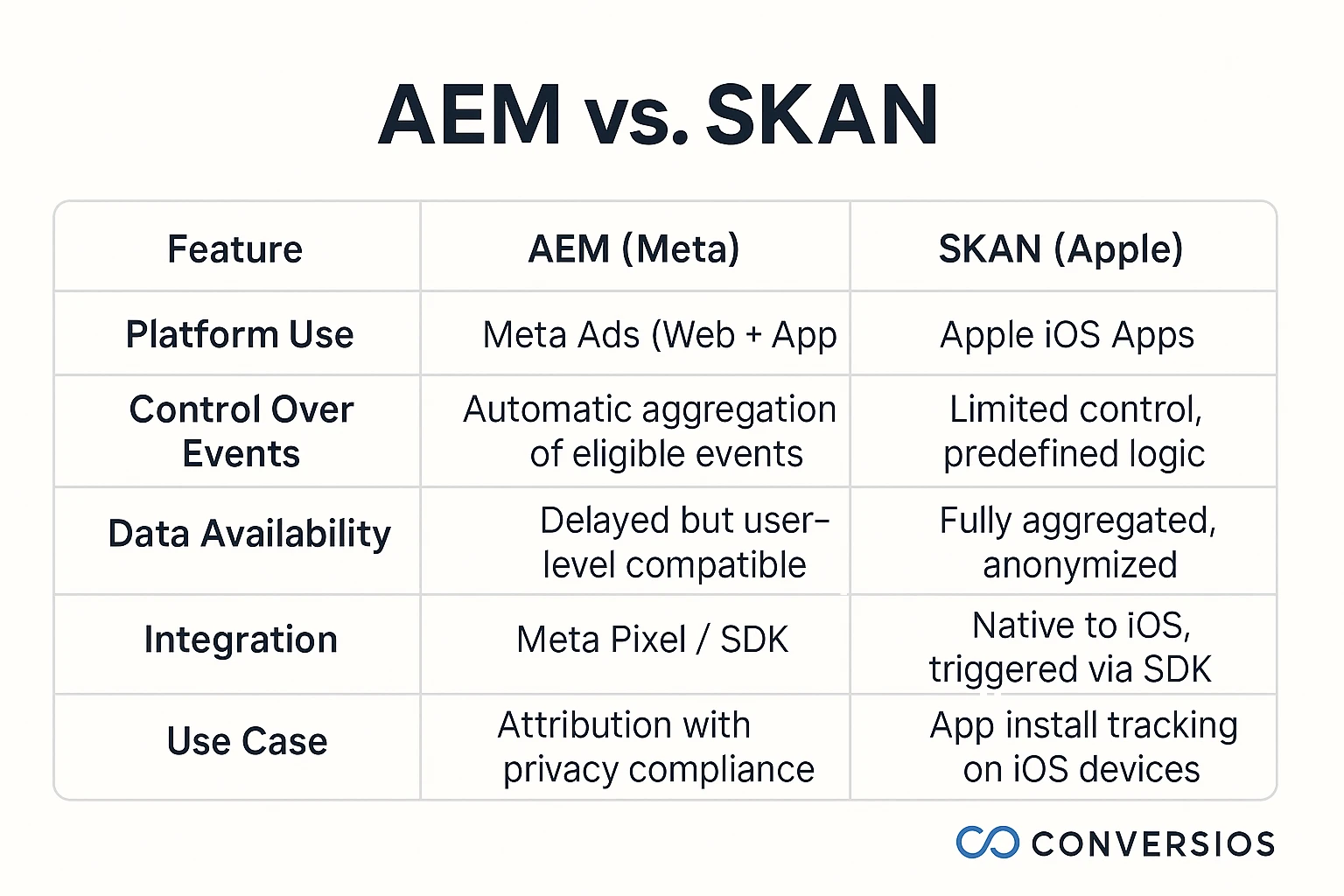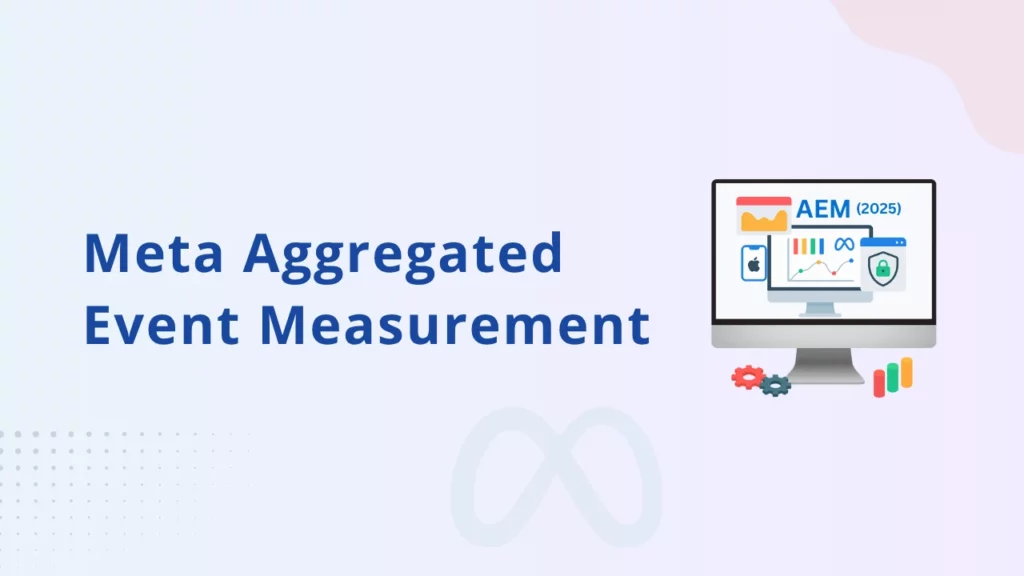Following Apple’s iOS 14 update, advertisers faced new restrictions on data collection, especially from users who declined tracking permissions. In response, Meta introduced Meta Aggregated Event Measurement (AEM).
Meta AEM is a privacy-first protocol that enables advertisers to measure conversions from opted-out users on Facebook and Instagram while respecting modern privacy standards.
Understanding how Meta Aggregated Event Measurement (AEM) works and ensuring it’s correctly implemented can significantly improve ad performance, attribution accuracy, and campaign optimization.
What Is Meta Aggregated Event Measurement?

Meta Aggregated Event Measurement (AEM) is a privacy‑focused system that measures web and app events from users on iOS 14.5+ devices—even if they opt out of tracking.
⚠️ Update – June 2025: Meta has removed the 8-event limit and no longer requires prioritization. All eligible standard and custom events are now automatically processed, without any manual list or ranking. The AEM configuration tab in Events Manager has been removed
Meta Aggregated Event Measurement (AEM) integrates seamlessly with your Pixel and Conversions API setup. Use the Meta Pixel Helper to verify browser‑side events, and validate both client and server‑side events in real time via the Test Events tab in Meta Events Manager.
Why Was AEM Introduced After iOS 14?
Apple’s iOS 14 update required apps to ask users for permission before tracking. As many opted out, Meta lost visibility into conversions from iOS devices.
Meta introduced AEM to preserve key signals while respecting user consent.
How Meta AEM Works Behind the Scenes
Prior to mid‑2025, AEM required selecting and prioritizing up to 8 conversion events per domain, reporting only the highest-ranked event from opted-out iOS users.
⚠️ June 2025 update: Meta has removed the 8-event limit and eliminated manual event prioritization. The standalone AEM configuration interface is gone, and Meta AEM now automatically aggregates all eligible events behind the scenes without manual intervention.
Under the hood, Meta AEM collects events from your Meta Pixel or Conversions API, and continues to integrate with Apple’s SKAdNetwork for app-based campaigns. Integrating with server-side GTM or Conversions API further enhances data accuracy and reliability.
Using AEM in Meta Events Manager (No Manual Setup Required)
With Meta’s June 2025 update, web event aggregation through AEM no longer requires manual configuration. Here’s what you need to know:
- The “Aggregated Event Measurement” tab has been removed from Meta Events Manager. You no longer need to configure AEM manually for web events.
- Domain verification is not required for AEM. It’s only necessary for link ownership or iOS app setup scenarios.
- You no longer need to select or prioritize up to eight events. Meta now aggregates all eligible events automatically, with no event cap.
- Your Pixel and Conversions API setup remains essential. Once implemented, Meta automatically handles event processing without any further steps.
- App campaigns that use AEM continue to be managed through the Meta SDK and Apple’s SKAdNetwork. These steps remain unchanged.
There’s no 72-hour delay after changes because manual event configuration is no longer required.
AEM vs SKAN: What’s the Difference?
Apple’s SKAdNetwork (SKAN) and Meta’s Aggregated Event Measurement (AEM) are both privacy-first tracking solutions but they serve different purposes. Here’s a quick comparison to understand when and where to use each. Use AEM when running web or app campaigns through Meta. SKAN is mandatory for iOS app installs. And both can work in parallel for better attribution coverage.

Optimizing Meta AEM in 2025 (No Event Ranking Needed)
Meta’s June 2025 update removed the need to configure, rank, or limit events for Aggregated Event Measurement (AEM). Here’s what you need to focus on now:
What’s changed:
-
AEM no longer requires manual event selection or ranking automatic aggregation only.
What You Should Do:
- Ensure your Meta Pixel and Conversions API are correctly implemented to send all event data.
- Maintain consistent event naming and schema across sources web, server, and app.
- Use Meta Events Manager tools (Test Events and Diagnostics) to monitor event health and signal quality.
- Deduplicate events reliably to prevent double-counting across Pixel and CAPI setups.
- Clean up redundant triggers or spammy events to ensure clean data pipelines.
Does AEM Still Matter in 2025?
Yes — Meta Aggregated Event Measurement (AEM) continues to play a vital role in a privacy-first environment:
- It ensures conversion modeling for users who opt out of iOS tracking.
- AEM automatically aggregates all eligible events, even after the removal of manual ranking and the 8-event cap.
- It works alongside the Conversions API (for reliable server-side tracking) and SKAdNetwork (for iOS app attribution) to maintain robust performance monitoring.
When combined – AEM + CAPI (+ SKAN for mobile apps) – delivers near-complete attribution and optimization coverage, even when user-level pixel data is restricted.
Final Thoughts:
- AEM is now fully automated – no ranking, no caps, no manual setup.
- Implementation quality is your priority: configure your Pixel and CAPI correctly, maintain consistent event schemas, and ensure deduplication.
- Verify event delivery and quality using Meta’s Test Events and Diagnostics tools.
- Pair AEM with CAPI and SKAN to maximize attribution and campaign performance across platforms..
Frequently Asked Questions
Q. What if I don’t use AEM?
You’ll miss conversions from opted-out iOS users, affecting attribution and campaign performance.
Q. Is the 8-event limit still in place?
No. Meta now supports unlimited events — no ranking or prioritization needed.
Q. Do I need to configure events manually?
No. Event setup is now automatic. Meta aggregates data without manual input.
Q. Is AEM still needed if I use Conversions API?
Yes. AEM models opted-out users; CAPI improves event delivery. Use both for full tracking.
Q. Has AEM been replaced or deprecated?
No. AEM remains active and fully supported in 2025.
Q. How does AEM handle Value Optimization (VO) in 2025?
When Value Optimization is enabled, AEM now considers the summed value of all eligible events, even for opted-out iOS users. There’s no need to rank value events — Meta automatically models conversion value in aggregate.

